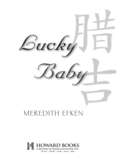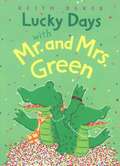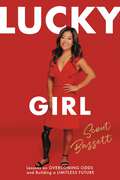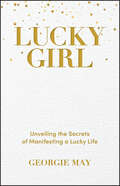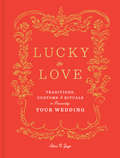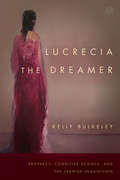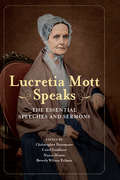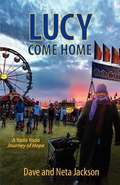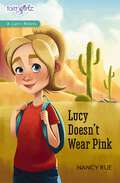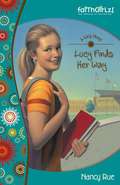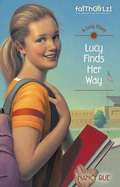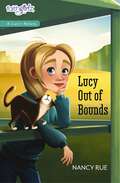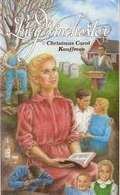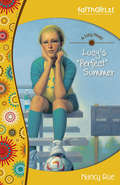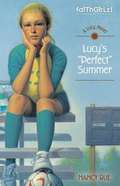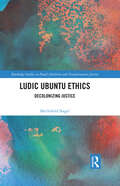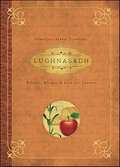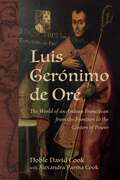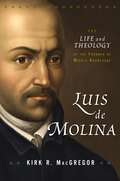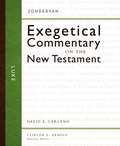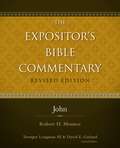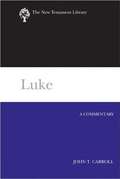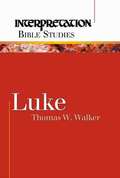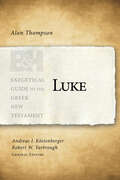- Table View
- List View
Lucky Baby
by Meredith EfkenMeg Lindsay has everything a woman could want except happiness. Can an adopted Chinese child bring her what she lacks?All her life, Meg Lindsay's mother told her what a disappointment she was. Try as she might, Meg never measured up, and the emotional bruises still hurt as an adult. In Meg's opinion, no one could be a worse mother than the woman who gave birth to her--that is, until Meg has a child of her own to care for.Two young girls lived in an orphanage in China. Unwanted because of a deformity and the lack of family registry, Little Zhen An was destined to spend her childhood in the orphanage. Her only friend was a slightly older blind girl, Wen Ming.After Meg and her husband, Lewis, adopt one of the girls, Meg's love for her new daughter grows daily, but the tension, fear, and uncertainty of motherhood drive Meg to the brink of despair. Fearing that she is becoming the kind of mother she hates, she fights circumstance, rebellion, a loving but at times tense marriage, setbacks, and the native selfishness that lives in all of us.Meg's journey is a magical one as East meets West and as imagination aligns with reality. Lucky Baby spans the world, bridges the gap between heart and soul, and shows that the greatest power on Earth is forgiveness.
Lucky Comes Home
by Dean HughesWhen his father is nearly killed in the aftermath of an earthquake, the incident helps Lucky accept the possibility that his father may remarry.
Lucky Days with Mr. and Mrs. Green
by Keith BakerMr. and Mrs. Green return for another round of sweet and adventurous alligator escapades. This time they're trying their hand at detective work, entering a gumball-guessing contest, and--most daring of all!--participating in the town talent show. Happily for the Greens, luck is on their side. Luck and cookies--JUMBO cookies!
Lucky Girl: Lessons on Overcoming Odds and Building a Limitless Future
by Scout BassettSprinter, long jumper, and Paralympian Scout Bassett shares the lessons she&’s learned battling the toughest challenges facing young women today. As an infant in China, Scout Bassett survived a fire that took her right leg. She spent the next seven years in an orphanage before being adopted and whisked away to the United States, where she felt foreign in every way. Though she defied the odds and became a gold medalist and world-record holder, Scout fought against adversity her entire life—and mostly off the track. As a person with a disability, a minority, and a woman in America, she&’s struggled in a culture that can make anyone—no matter who you are—feel like an outsider—an other. In Lucky Girl Scout shares ten lessons she&’s learned to help readers overcome some of the most difficult challenges in life today. With vulnerability, humor, and warmth, she addresses issues of identity, loneliness, image, purpose, and high expectations, among others, and offers advice for how to face them. Scout began her journey to embrace who she is—past and all—by never forgetting where she comes from or who she is. With this guidebook on adversity and life, learn how to make peace with your past, own your identity, and create your own luck.
Lucky Girl: Unveiling the Secrets of Manifesting a Lucky Life
by Georgie May“This must-read book debunks and critiques the Lucky Girl viral movement whilst providing you with all the tools you need to make your dreams come true. Brilliant.” Vicki Broadbent, founder of honestmum.com, author and broadcaster A helpful and inclusive guide to bringing more good luck into your life Unlock a vibrant and empowering journey with Lucky Girl, guided by Georgie May, a leading wellness expert and social media strategist. Lucky Girl provides a refreshing evidence-based approach which will infuse your life with excitement and positivity, allowing you to tap into your inherent skills and talents to attract abundance and luck. Within the pages of this captivating book, a treasure trove of easy-to-implement tools, transformative practices, and enchanting rituals are shared. These will propel you towards profound shifts, empowering you to embrace the life you truly desire. Say goodbye to your unlucky streak and unlock the door to a world of endless possibilities by learning: Strategies for challenging your situation and replacing it with a simple thought process that will power your hopes and dreams Techniques to help you identify why your luck seems so bad and how to change it Methods to help you manifest good luck based on contemporary research and case studies Practical tools to help you create your Lucky Girl Goals and learn resources on how to make them finally stick With Lucky Girl as your trusted companion, discover the secrets to living your best life. A book applicable to all ages and genders, allow Lucky Girl to inspire and uplift you as you embark on a journey of self-discovery, awareness, and personal growth. It's time to manifest the luck you deserve and embrace a life full of true authenticity, joy, and fulfillment. Are you ready to seize the reins of destiny and step into a brighter future? Let Lucky Girl be your guiding star on this transformative adventure!
Lucky in Love: Traditions, Customs, and Rituals to Personalize Your Wedding
by Eleni N. GageEvery engaged couple wants two things: a meaningful wedding and a lifetime of happiness. This great gift book is a cross-cultural collection of marriage folklore that will help you achieve both. Create your own lucky traditions with nods to each other’s heritage, customs from places you’ve visited together, and auspicious rituals that just feel special. Whether you are just engaged or you’re days away from tying the knot, you’ll gain insight every step of the way. With this book as your guide, you can make your own luck in love.
Lucrecia the Dreamer: Prophecy, Cognitive Science, And The Spanish Inquisition (Spiritual Phenomena Ser.)
by Kelly BulkeleySet in late sixteenth-century Spain, this book tells the gripping story of Lucrecia de León, a young woman of modest background who gained a dangerously popular reputation as a prophetic dreamer predicting apocalyptic ruin for her country. When Lucrecia was still a teenager, several Catholic priests took great interest in her prolific dreams and began to record them in detail. But the growing public attention to the dreams eventually became too much for the Spanish king. Stung that Lucrecia had accurately foreseen the defeat of the Spanish Armada in 1588, Philip II ordered the Inquisition to arrest her on charges of heresy and sedition. During Lucrecia's imprisonment, trial, and torture, the carefully collected records of her dreams were preserved and analyzed by the court. The authenticity of these dreams, and their potentially explosive significance, became the focal point of the Church's investigation. Returning to these records of a dreamer from another era, Lucrecia the Dreamer is the first book to examine Lucrecia's dreams as dreams, as accurate reports of psychological experiences with roots in the brain's natural cycles of activity during sleep. Using methods from the cognitive science of religion, dream researcher Kelly Bulkeley finds meaningful patterns in Lucrecia's dreaming prophecies and sheds new light on the infinitely puzzling question at the center of her trial, a question that has vexed all religious traditions throughout history: How can we determine if a dream is, or is not, a true revelation?
Lucretia Mott Speaks: The Essential Speeches and Sermons (Women, Gender, and Sexuality in American History)
by Carol Faulkner Christopher Densmore Lucretia Mott Nancy A HewittCommitted abolitionist, controversial Quaker minister, tireless pacifist, fiery crusader for women's rights--Lucretia Mott was one of the great reformers in America history. Drawing on widely scattered archives, newspaper accounts, and other sources, Lucretia Mott Speaks unearths the essential speeches and remarks from Mott's remarkable career. The editors have chosen selections representing important themes and events in her public life. Extensive annotations provide vibrant context and show Mott's engagement with allies and opponents. The result is an authoritative resource, one that enriches our understanding of Mott's views, rhetorical strategies, and still-powerful influence.
Lucy Come Home
by Dave Jackson Neta JacksonFifteen-year-old Cindy worked long days beside her migrant worker family in Michigan's sugar beet fields in the early 1940s--the "war years"--until she met a dashing young man from a traveling carnival, bringing some joy and fun into her hard-scrabble life. But a tragic twist of fate--and a dead field boss--sent the two young people on the run, leaving behind family and everything she'd ever known. Lucy Tucker, the crotchety old bag lady from the popular Yada Yada House of Hope series, is a veteran of the Chicago streets and not about to give up her independence, even as she approaches her 80th birthday. Until, that is, a young displaced woman with her gentle ageing mother and a dog named Dandy seem to need her--unsettling the secretive Lucy, who doesn't let anyone get too close. But just when it seems her past is catching up with her to bring her in out of the cold.
Lucy Doesn't Wear Pink (Faithgirlz / A Lucy Novel)
by Nancy RueMeet Lucy Rooney, a motherless tomboy with an inquisitive mind, a strong will, and a straight-forward approach, who knows every inch of the small and dusty New Mexico town in which she lives with her blind father. She is constantly searching for the "why" in everything. Sometimes it helps answer her questions, and sometimes it just gets her into trouble.
Lucy Finds Her Way
by Nancy N. RueLucy Rooney is a feisty, precocious tomboy who questions everything—even God. It’s not hard to see why: a horrible accident killed her mother and blinded her father, turning her life upside down. It will take a strong but gentle housekeeper—who insists on Bible study along with homework—to show Lucy that there are many ways to become the woman God intends her to be. Aunt Karen is taking over Lucy’s life—what’s left of it. Middle school is hard enough, with a new set of teachers and kids and preparing for the big soccer tryouts. But now Aunt Karen has moved in, imposing wardrobe inspections, threatening to get rid of the cats, and trying to be the world’s original soccer mom. It takes all Lucy’s got just to cope. When J.J. and Januarie are abducted by their father, Lucy mobilizes everyone to find them. Lucy’s a good detective—but she ends up a hostage too. In the fourth and last installment in the Lucy Novels, Lucy must depend on an unlikely ally to find her way out of this mess and in life.
Lucy Finds Her Way
by Nancy RueAs twelve-year-old Lucy prepares for the Olympic Development Program soccer try-outs, she struggles with the complexities of middle school, her relationship with her best friend, and Aunt Karen, who is trying to take over her life while her father is away.
Lucy Out of Bounds (Faithgirlz / A Lucy Novel)
by Nancy RueWhen boy-crazy Mora, Inez's girly-girl granddaughter, turns on Lucy to take JJ away from her and even tries to sabotage Lucy so she'll have to go live with her dreaded Aunt Karen, Lucy learns, with the help of the Book of Ruth, how to forgive the unforgivable.
Lucy's Perfect Summer
by Nancy N. RueLucy has come a long way from that tomboy who wouldn’t give pink the time of day. She’s developed into an authentic tween who has learned that girls make great friends, that teamwork means more than stardom, and that God is real. But she’s still Lucy. In the third book of the series, she runs headlong into some new—and some old—problems. Although Lucy has come to love and respect Inez and more than tolerate Mora, with school out for the summer, the three of them have more together time than anybody can stand! That worsens when the “monsoon” season keeps them cooped up in the house for three solid days without Dad to referee (he’s stranded at the radio station). When Dad is stuck at the radio station without his assistant Luke, the new management finds out just how much Dad depends on his assistant and threaten to fire Lucy’s father. Lucy is freaked out at the thought of moving. Plus it gives Aunt Karen more ammunition for her fight to have Lucy come and live with her in El Paso. That would be heinous enough, but Lucy just can’t leave now, not with the soccer team making tremendous progress and Coach Auggy scheduling three unofficial games with neighboring teams during the summer to get them ready for the real soccer season in the fall. And not with Januarie getting into “iffy” territory with the new kids her own age that Lucy and her friends have encouraged her to hang out with so she’ll leave them alone. Child Protective Services gets involved when Januarie gets in trouble, and Lucy has to be there for her, especially since this could affect her friend J.J. too. When the weather dries up, wild fires break out with a vengeance. A big one threatens Los Suenos. Myteriously, the only thing destroyed is the soccer field. The big developer who has tried to buy the property before swoops in for the kill. Lucy and her team have to convince the town to come together and restore the field, rather than give up and sell it. Meanwhile, Lucy, Mora, Dusty, Veronica, and Inez study Esther. Lucy grows even closer to God through her Book of Lists and her resonance with Esther, even though she was a girly-girl. That helps her not only save the soccer field, get Januarie out of trouble, and get herself an audition with the Olympic Development Program (without Aunt Karen’s help), but it enables her to make a huge sacrifice for Dad and agree to live without him for six weeks while he goes to a special technology school for the blind in Alamogordo. That’s going to mean having Aunt Karen come to live with her in the fall. But Lucy is the only one who can do this thing in this time and this place. Like Esther, she is willing to make the sacrifice.
Lucy's Perfect Summer
by Nancy RueFacing up to a cheater at an elite soccer day camp and some difficult events at home helps eleven-year-old Lucy do some growing up during a summer which, while very different from the one she imagined, turns out to be just right.
Ludic Ubuntu Ethics: Decolonizing Justice (Routledge Studies in Penal Abolition and Transformative Justice)
by Mechthild NagelLudic Ubuntu Ethics develops a positive peace vision, taking a bold look at African and Indigenous justice practices and proposes new relational justice models. ‘Ubuntu’ signifies shared humanity, presenting us a sociocentric perspective of life that is immensely helpful in rethinking the relation of offender and victim. In this book, Nagel introduces a new theoretical liberation model—ludic Ubuntu ethics—to showcase five different justice conceptions through a psychosocial lens, allowing for a contrasting analysis of negative Ubuntu (eg., through shaming and separation) towards positive Ubuntu (eg., mediation, healing circles, and practices that no longer rely on punishment). Providing a novel perspective on penal abolitionism, the volume draws on precolonial (pre-carceral) Indigenous justice perspectives and Black feminism, using discourse analysis and a constructivist approach to justice theory. Nagel also introduces readers to a post secular turn by taking seriously the spiritual dimensions of healing from harm and highlighting the community’s response. Spanning disciplinary boundaries and aimed at readers seeking to understand how to move beyond reintegrative shaming and restorative justice theories, the volume will engage scholars of criminology, philosophy and law, and more specifically penal abolitionism, social ethics, peace studies, African studies, critical legal studies, and human rights. It will also be of great interest to practitioners and activists in restorative justice, mediation, social work, and performance studies.
Lughnasadh: Rituals, Recipes & Lore for Lammas (Llewellyn's Sabbat Essentials)
by LlewellynLughnasadh—also known as Lammas—is the beginning of the harvest season, marking the point where the first fruit of the land has ripened. This guide to Lughnasadh shows you how to perform rituals and work magic around the gratitude we feel for plans that have come to fruition and explore themes of fertility, protection, and reflection.RitualsRecipesLoreSpellsDivinationCraftsCorrespondencesInvocationsPrayersMeditationsLlewellyn's Sabbat Essentials explore the old and new ways of celebrating the seasonal rites that are the cornerstones of the witch's year.
Luis Gerónimo de Oré: The World of an Andean Franciscan from the Frontiers to the Centers of Power (New Hispanisms: Cultural and Literary Studies)
by Noble David Cook Alexandra Parma CookBorn in a provincial city in the Peruvian Andes, the Franciscan linguist and theologian Luis Gerónimo de Oré (1554–1630) lived during a critical period in the formation of the modern world, as the global empire of Spain engaged in a nearly continuous struggle over resources and religion.In the first full-length biography of Oré, Noble David Cook and Alexandra Parma Cook reconstruct the friar’s life and the communities in which he circulated, tracing the career of this first-generation Creole from his roots in Huamanga to his work in Andean missions, his activities at the royal courts of Spain and throughout Spanish America, until his final years as bishop of Concepción, Chile. While serving in Peru’s Colca Valley, Oré composed multilingual texts, translating doctrinal concepts into the indigenous languages Quechua and Aymara, alongside Latin and Spanish, which missionaries and secular clergy frequently used in their conversion efforts. As commissioner to Cuba and La Florida, he inspected the frontier missions along the coast of what became the southeastern United States and wrote an influential history of these outposts and their environment. After Philip III dispatched him to Concepción, Oré spent his last years working in the southernmost end of the Americas, where he continued his advocacy for indigenous justice and engaged in heated arguments with the governor over defensive war, royal patronage, and Indian enslavement.Drawn from research conducted in Spain and Latin America over several decades, this consequential biography recovers from obscurity a colonial friar whose legacy continues in the Andean world today.
Luis de Molina: The Life and Theology of the Founder of Middle Knowledge
by Kirk R. MacgregorWhen Luis de Molina died in Madrid in 1600, he had every reason to believe he was about to be anathametized by Pope Clement VIII. The Protestant Reformation was splitting Europe, tribunals of the Inquisition met regularly in a dozen Spanish cities, and the Pope had launched a commission two years earlier to investigate Molina’s writings. Molina was eventually vindicated, though the decision came seven years after his death. In the centuries that followed Molina was relegated to relatively minor status in the history of theology until a renaissance of interest in recent years. His doctrine of God’s “middle knowledge,” in particular, has been appropriated by a number of current philosophers and theologians, with apologist William Lane Craig calling it “one of the most fruitful theological ideas ever conceived.” In Luis de Molina: The Life and Theology of the Founder of Middle Knowledge, author Kirk R. MacGregor outlines the main contours of Molina’s subtle and far-reaching philosophical theology, covering his views on God’s foreknowledge, salvation and predestination, poverty and obedience, and social justice. Drawing on writings of Molina never translated into English, MacGregor also provides insight into the experiences that shaped Molina, recounting the events of a life fully as dramatic as any of the Protestant Reformers. With implications for topics as wide-ranging as biblical inerrancy, creation and evolution, the relationship between Christianity and world religions, the problem of evil, and quantum indeterminacy, Molina’s thought remains as fresh and relevant as ever. Most significantly, perhaps, it continues to offer the possibility of a rapprochement between Calvinism and Arminianism, a view of salvation that fully upholds both God’s predestination and human free will. As the first full-length work ever published on Molina, Kirk MacGregor’s Luis de Molina provides an accessible and insightful introduction for scholars, students, and armchair theologians alike.
Luke
by David E. Garland Clinton E. ArnoldThis series is designed for those who know biblical languages. It is written primarily for the pastor and Bible teacher, not for the scholar. That is, the aim is not to review and offer a critique of every possible interpretation that has ever been given to a passage, but to exegete each passage of Scripture succinctly in its grammatical and historical context. Each passage is interpreted in the light of its biblical setting, with a view to grammatical detail, literary context, flow of biblical argument, and historical setting. While the focus will not be on application, it is expected that the authors will offer suggestions as to the direction in which application can flow.
Luke
by Tremper Longman III David E. Garland Walter L. Liefeld David W. PaoContinuing a Gold Medallion Award-winning legacy, this completely revised edition of The Expositor’s Bible Commentary series puts world-class biblical scholarship in your hands. Based on the original twelve-volume set that has become a staple in college and seminary libraries and pastors’ studies worldwide, this new thirteen-volume edition marshals the most current evangelical scholarship and resources. The thoroughly revised features consist of: • Comprehensive introductions • Short and precise bibliographies • Detailed outlines • Insightful expositions of passages and verses • Overviews of sections of Scripture to illuminate the big picture • Occasional reflections to give more detail on important issues • Notes on textual questions and special problems, placed close to the texts in question • Transliterations and translations of Hebrew and Greek words, enabling readers to understand even the more technical notes • A balanced and respectful approach toward marked differences of opinion
Luke
by John T. CarrollThis new, authoritative commentary on the Gospel of Luke epitomizes the New Testament Library series. Combining scholarly rigor and theological insight, Carroll not only focuses on the Gospel text but also makes frequent reference to Luke's second volume, the Acts of the Apostles, to show how the two writings work together to present a full picture of the life of Christ and the work of the apostles. In addition, Carroll includes several illuminating notions about special topics in Luke's Gospel: a comparison of the birth announcements to Mary and Zechariah, an examination of the role of women, a discussion of wealth and poverty, and insights on the reign of God and the Roman Empire.
Luke
by Thomas W. WalkerWhile others might tell stories claiming the world is without promise, Luke presents the narrative of Jesus Christ as good news, challenge, and hope. For Luke, this is the only story that makes sense of the past, offers guidance for the present, and secures hope for the future. Interpretation Bible Studies (IBS) offers solid biblical content in a creative study format. Forged in the tradition of the celebrated Interpretation commentary series, IBS makes the same depth of biblical insight available in a dynamic, flexible, and user-friendly resource. Designed for adults and older youth, IBS can be used in small groups, in church school classes, in large group presentations, or in personal study.
Luke (Exegetical Guide to the Greek New Testament)
by Alan J. ThompsonThe Exegetical Guide to the Greek New Testament (EGGNT) closes the gap between the Greek text and the available lexical and grammatical tools, providing all the necessary information for greater understanding of the text. The series makes interpreting any given New Testament book easier, especially for those who are hard pressed for time but want to preach or teach with accuracy and authority. <P><P> Each volume begins with a brief introduction to the particular New Testament book, a basic outline, and a list of recommended commentaries. The body is devoted to paragraph-by-paragraph exegesis of the Greek text and includes homiletical helps and suggestions for further study. A comprehensive exegetical outline of the New Testament book completes each EGGNT volume.
